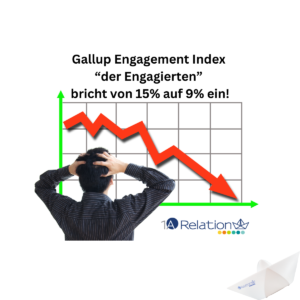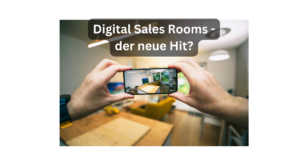A study supports my years of experience. Only those who nurture both employees and customers reap the full rewards of success. Customer loyalty alone is only half the battle
These findings and summary come from a study by Detecon and DE3P.
Let’s start with the most important thesis of the study : “Organization Experience integrates needs of customers and employees alike to unleash the full potential of organizational and cultural development.”

Six dimensions lead to an Organization Experience
In practice, it is relevant to focus on both employees and customers and to see their needs as the starting point for designing a shared experience. In order to design this shared experience, action should be taken across silos.
In Figure 4 (source 1A Relations GmbH), we have been illustrating this connection for years.
Only with this study did we get empirical validation.

Employer Experience und Customer Experience = Organization Experience
What has just been described leads us to two further theses of the study:
Thesis 1: “Companies cannot assume to understand their customers* until they know the needs and desires of the people they interact with.”
Thesis 2: “A positive Employee Experience enables us to create an exceptional atmosphere that can also have a significant impact externally. At the same time, interaction with satisfied and appreciative customers* is also valuable and meaningful for employees.”
I.e. when we talk about loyalty programs for customers, we also have to talk about employee care – i.e. loyalty programs for employees.
So far so good, but is there an empirical, i.e. causal connection?
The authors write the following (the sources for this are deposited in the study):
“For example, there are positive correlations between employee satisfaction and the economic success of a company 1 as well as the satisfaction of customers*. 2, 3 Further research shows that companies that do particularly well in Employee Experience are more successful and profitable than companies that provide a poorer Employee Experience to their employees. 4, 5”
What are the six impact dimensions in detail? (Texts are an excerpt of the study results)
Scope for action
How do we shape culture and processes so that our employees have enough freedom to act
to act on their own responsibility in the interest of the best customer experience? How do we enable our customers to use our products and services according to their preferences?
Competence
What competencies do our employees need in order to be able to act in the sense of an optimal customer experience?
experience? How do we enable our customers to use our products or services safely and to get answers to questions quickly?
Technical equipment
What technical equipment do our employees need in order to guarantee an optimal
customer experience and feel comfortable and valued in the process? What does our system need to be able to do in order to ensure a positive customer experience in our digital corporate infrastructure?
Values, Culture & Mindset
Which values do we need to anchor in the company in order to create positive key moments for employees and customers?
for employees and customers? How can we live our desired values in a group in order to establish a culture?
Brand
What are the most important points of contact between our brand, employees and customers?
customers? Do we take relevant measures in the employee and customer journey that lead to long-term recommendation and loyalty?
Feedback tools and co-creative methods
Which tools and methods do we use to promote the experience of employees and customers alike? How can we use system and tool support to make our employees more aware of the needs and experiences of both customers and employees?
What does this mean in practice (the following texts are taken from the study, adapted and supplemented by the author)?
Room for maneuver: From the employees’ point of view: sufficient time, budget and freedom to decide for themselves.
Customer perspective: Scope to discover/decide for oneself what suits one best.
Competence:Employees’ point of view: Education and training
Customer perspective: Help such as FAQs, videos, checklists, instructions.
Technical equipmentEmployees’ view: The appropriate tools with the appropriate usability
Customer view: Customer journeys, landing pages and tools that meet their needs – all barrier-free.
Values&MindsetEmployees’ view: Value propositions and how leadership can deliver on them.
Customer view: Value expectations and their fulfillment or confirmation.
Brand/brand view Employees: Values and brand promises are in harmony à another study from 2010 says: employees who have internalized brand promises create greater loyalty
Customer perspective: Brand promise is confirmed by value behavior, overfulfilled à loyalty
Feedback tools and co-creative methodsEmployees: Receive feedback from customers à leads to improvement of behavior, processes, etc.Customer perspective: The option to give feedback at any time, which is also accepted through active listening.
Both together: Create added value for both sides through co-creation as a CIP.
Furthermore, a lot more exciting results are shared that are worth taking a closer look at.
Finally, a few comments:
- One page of the study says “Employee Experience is the New Customer Experience.” No, this is not so. Perhaps the authors made a small mistake here. Because, as in the six dimensions and respective perspectives above, one thing becomes clear: It only works together. Customer experience is not replaced by employer experience. It is improved enormously because the employer experience becomes the focus of leadership tasks.
- And the term “leadership” brings me to my second point of departure: I don’t see the importance of leadership tasks in the study. Without this new type of leadership management, the whole thing lacks a framework and support. Because new goals and tasks should also be included in the annual goals and target agreements of the “new, customer-oriented company”. And this applies to everyone: Starting with the executives to the process owners and the teams. Personal goals move into the background.
Third point: Certainly, one can argue about this remark, but that is precisely why I am making it: In the author’s experience, brand belongs to the dimension of “values and mindset”.
Further sources on the subject are as follows
Here the video with Dr. Guido Beier
If you want to “jump” directly to the most important sentence: from min. 46:30 “We want to create (better) relationships between our employers and our customers”.
Source: The video is from the series “CRMKonvos” https://www.youtube.com/@crmkonvos with my friends Ralf Korb, Thomas Wieberneit, Marshall Lager
PS: The study design at a glance













